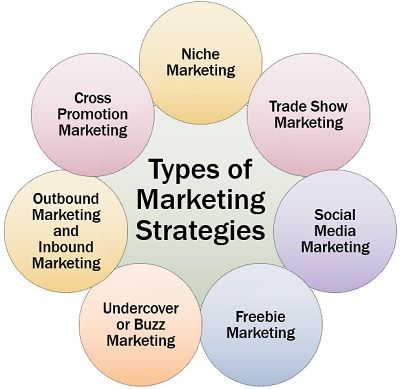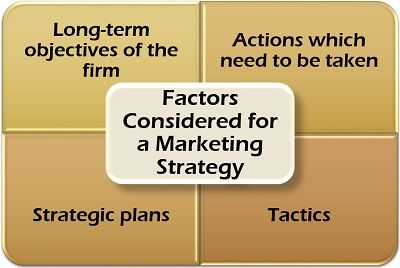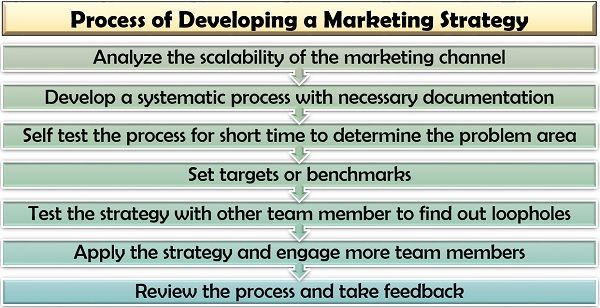Definition: Marketing strategy is a planned and systematic approach to develop a recall value in the mind of the potential customers for the product and increase its sale. It deals with building up of brand image in the market and enhance the sales of the product along with maintaining a long term relationship with the customers.
It is a continuous practice of promoting a product’s unique selling proposition (USP) among its consumers and maximizing profitability in the long run.
Content: Marketing Strategy
Types of Marketing Strategies
With the changing technology, consumers have become smarter. They now seek more and more information about the various options available in the market before actually buying a particular product.
The companies make use of marketing strategy to penetrate the market and covert such potential audience into buyers.
Following are the different marketing strategies which the companies may adopt to reach out to its target consumers:
The business organizations can go for any of the above strategies, depending on the factors which are discussed further in this content. To understand each approach in detail, read below.
Niche Marketing
This marketing strategy targets a defined demographic, psychographic and geographic market segment to become the market leader or specialist in a particular product.
In this marketing strategy, the competition is quite low, and the market size also decreases. But the company has the chance of capturing that whole market segment.
For Example; The Sony Pictures Networks India Pvt. Ltd. launched SAB TV channel. The aim was to target those Indian viewers who are interested in watching daily operas and comedy shows.
Trade Show Marketing
The trade show marketing strategy brings all the people dealing in a particular industry under a single roof. It is one of the popular strategy opted by the small organization to acquire bulk orders and meet new customers, vendors, partners, etc. for the growth of the business.
This marketing strategy requires efforts like demonstrations, displays, shows, offers, discounts, samples, etc. to capture the attention of the audience and visitors.
For Example; In North America, an event named JCK Las Vegas is organized each year for the jewellery professionals around the world to showcase their piece of art and collection. It is the centre of attraction for the diamond and precious stone jewellery seekers.
Social Media Marketing
With the increase in the use of social media, it is rapidly used by the business organization to communicate with a large number of audience and convert them into buyers.
Customers are free to share their reviews and feedback about the product and the brand over social media. These reviews hold high credibility and build trust among other potential customers for the company.
For Example; The apparel brand ASOS appeal the customers to hashtag their pictures in the ASOS apparels while posting them on social media. These pictures are shown on the brand’s Instagram news feed to capture the attention of potential customers. The company even adds a number and description of the image for the viewers to identify the apparel while online shopping.
Freebie Marketing
This marketing strategy psychologically influences the buyers by giving out a low-value product as a gift with a high-value product. Getting something additional or complementary enhances the satisfaction level of the customers.
For Example; Vaseline brand provides a small pack of vaseline cocoa buttercream free with the vaseline intense body care bottle for increasing sale.
Undercover or Buzz Marketing
In the undercover marketing strategy, the company, even before launching the product, creates a buzz or sensation about it. It brings enthusiasm, excitement, eagerness and curiosity among the target audience. This type of marketing strategy is usually done for a new or innovative product.
For Example; Reliance Jio created a lot of buzz among the Indian audience for its free unlimited data and calling service for three months to the registered user. It was a considerable success counting to more than 16 million subscribers on its launch.
Outbound Marketing and Inbound Marketing
In outbound marketing, the company has to make efforts to reach out the potential customers through advertisements, telemarketing, cold calling, flyers, etc. The organization aims at selling its product to the customers.
For Example; Oppo Electronics Corporation adopted an outbound marketing strategy to sell its smartphones in India. The mobile retail outlets convinced the customers to buy the product by explaining them the various benefits.
Inbound marketing is promoting the product among a vast audience through social media, blogging, vlogging, websites, etc. It does not require many sales efforts, and the curious customers themselves approach the company for buying the products. This strategy builds the company’s goodwill and makes it a pull brand.
For Example; Xiami’s mobiles launched on Flipkart is the perfect example of inbound marketing. The buyers wait for the launch, and the company can sell 1 lakh handsets in a second.
Cross Promotion Marketing
Under cross-promotion marketing, one brand partners with one or more non-competitive brand to target similar customers for entirely different products. It is a strategy which is cost-efficient and extends the target market.
For Example; Nestle and Paytm partnered where Kitkat was promoted with free Paytm cash of the same value as the price of the KitKat. It helped Nestle to increase its sale and Paytm to attract many customers.
Factors Considered for a Marketing Strategy
The company opts for a particular marketing strategy by taking into consideration its finance, product specification, competition, customer’s need, etc.
There are undoubtedly other factors, too, which influences the formation of a company’s marketing strategy. These are as follows:
- Long-term objectives of the firm: It is essential for the company to plan its vision and determine where it wants to see itself in the long term. This vision is the base of all business strategies, and so is for the marketing strategy of the company.
- Actions which need to be taken: Only vision will take the company nowhere, it needs to be backed up by a strong mission or plan of action. The marketing strategy adopted must align with the organization’s mission.
- Strategic plans: Knowing the company’s in and out, i.e. the product specification, strengths, weaknesses, marketing mix, marketing channel, sales budget, etc. is necessary to select a useful marketing strategy.
- Tactics: Various short-term tactics like freebies, sales discount, lucky draws, contests, etc. supports the marketing strategy adopted and attracts more customers in the short run.
Process of Developing a Marketing Strategy
The formation of a marketing strategy is step by step process. It includes the following:
In the present scenario, when the consumers are aware, the market has globally evolved, and the competition is tremendous, only a smart marketing strategy can help a company to achieve its vision and create a strong presence in the mind of the target customers.
Leave a Reply